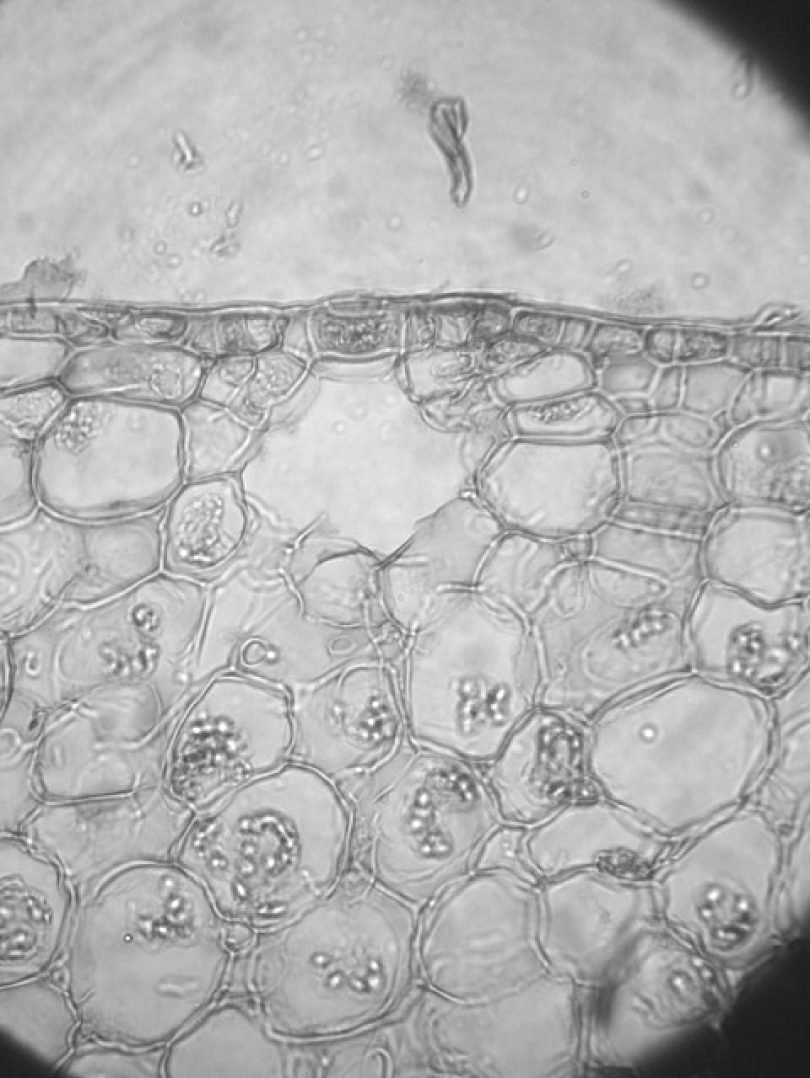Сhlorenchyma in stem of succulent plants from the genus Euphorbia L. (Euphorbiaceae)
Abstract
The necessity of photosynthesis execution by stems causes the structural and functional changes in plants. The stems of majority of succulent plants of the genus Euphorbia L. are covered only with the epidermis for a long time. In plants of some species the palisade parenchyma can appear which can be considered as a secondary or consequential tool to perform photosynthesis function by their stems. The anatomical structure of green annual stems of 23 Euphorbia species was examined. For 12 of them the palisade parenchyma has been established. The palisade parenchyma in the stem differs from such in the leaf by cells form and size as well as cells arrangement. The presence or absence of palisade parenchyma in the primary cortex indicates the level of specialization of stem tissues to perform the assimilation function. As the degree of development of palisade parenchyma depends on the amount of solar radiation, the presence and number of palisade parenchyma does not directly confirm the adaptation to the growth in conditions of a certain degree of aridity. Its appearance is could be caused also by growth under high insolation. Undoubtedly, appearance of palisade parenchyma in the stems of stem-succulent plants is correlated with reduction of leaves and probably is consequence of this.
References
Васильев А.Е., Воронин Н.С., Еленевский А.Г., Серебрякова Т.И., Шорина Н.И. 1988. Ботаника: Морфология и анатомия растений: учеб. пособие для студентов пед. ин-тов по биол. и хим. спец. Просвещение, Москва
Васильев Б.Р. 1988. Строение листа древесных растений различных климатических зон. Издательство Ленинградского университета, Ленинград.
Гайдаржи М.М., Нікітіна В.В., Баглай К.М. 2011. Сукулентні рослини (Анатомо-морфологічні особливості, поширення й використання). ВПЦ «Київський університет», Київ.
Гамалей Ю.В., Шийревдамба Ц. 1988. Структура растений Заалтайской Гоби. В кн.: Гамалей Ю.В., Гунин П.Д., Камелин Р.В., Слемнев Н.Н. (ред.), Пустыни Заалтайской Гоби. Характеристика растений-доминантов: 44–106. Наука, Ленинградское отд-ние, Ленинград.
Калашник С.О. 2009. Особливості продихового апарату видів роду Euphorbia L. (Euphorbiaceae Juss.) з різними типами пагонів. Збереження біорізноманіття тропічних і субтропічних рослин (мат-ли міжнар. наук. конф., Київ, 2009): 115–119.
Калашник С.О. 2014. Співвідношення площі листків та зелених стебел і ступінь редукції листків у сукулентних рослин роду Euphorbia L. (Euphorbiaceae Juss.). Mod. Phytomorphol. 6: 277–281.
Калашник С.О., Гайдаржи М.М. 2013. Анатомічна характеристика стебел однорічних пагонів сукулентних рослин роду Euphorbia L. (Euphorbiacae). Укр. ботан. журн. 70 (1): 45–53.
Ромейс Б. 1954. Микроскопическая техника. Издат. иностр. лит., Москва
Эзау К. 1980. Анатомия семенных растений. Мир, Москва.
Breyer C., Knies G. 2009. Global energy supply potential of concentrating solar power. Proc. SolarPAСES: 1–9.
Carter S. 2004. Euphorbia. Illustrated handbook of succulent plants: Dicotyledons: 102–203. Springer-Verlag, Berlin.
Mauseth J.D. 2004. The structure of photosynthetic succulent stems in plants other than cacti. Int. J. Plant Sci. 165 (1): 1–9.
Steinmann V.W. 2000. Comparative anatomy of the New World succulent Euphorbia (Euphorbiaceae). Botany 2000! (Oregon Convention Center, 6-10 August, 2000 Portland, OR): 40. http://www.botany.org/bsa/portland/section2/abstracts/40.shtml


This work is licensed under a Creative Commons Attribution-NonCommercial-NoDerivatives 4.0 International License.
The journal is licensed by Creative Commons under BY-NC-ND license. You are welcome and free to share (copy and redistribute the material in any medium or format) all the published materials. You may not use the material for commercial purposes. You must give appropriate credit to all published materials.
The journal allow the author(s) to hold the copyrights and to retain publishing rights without any restrictions. This is also indicated at the bottom of each article.





